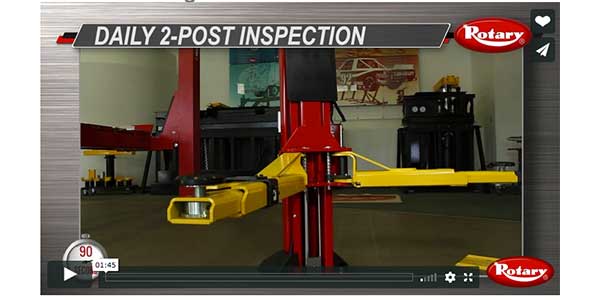
The latest in Rotary Lift’s “90 Second Know How” video series, “2-Post Daily Inspection,” outlines 10 steps Rotary recommends technicians take at the start of every shift to ensure their two-post lifts are operating properly. Watch it here: rotarylift.com/News-and-Resources/Training-Video-Library/ – video-14.
“This daily two-post lift inspection is a simple visual and operational checklist of the warning signs that something may be amiss with your two-post lift,” says Scott Field, an Automotive Lift Institute (ALI) Factory Designated Trainer with Rotary Lift. “Our goal for this and all of our 90 Second Know How videos is to cut to the chase, get right to the point, and succinctly provide the information our customers can use – with no superfluous fanfare. Shop managers can easily and quickly share this video with their staff, without wasting valuable time.”
In addition to daily walk-arounds by the lift operator, all installed vehicle lifts should be inspected at least annually by an ALI Certified Lift Inspector. If repairs are needed, the local Rotary Lift distributor can provide fast service to get the lift back in service quickly.
“The two-post lift is the most widely used vehicle lift style in the world. It’s the bread and butter piece of service equipment for many shops,” Field says. “Our two-post daily inspection video highlights the ounce of prevention that can save shop owners a pound of headaches.”
To watch any of Rotary Lift’s 90-Second Know How videos, visit rotarylift.com/News-and-Resources/Training-Video-Library/. To learn more about Rotary Lift’s complete line of two-post lifts, visit rotarylift.com/LIGHTDUTY/Two-Post-Lifts/, contact your local Rotary Lift distributor or call (800) 640-5438. You can also find Rotary Lift on Facebook, facebook.com/RotaryLift, Twitter, twitter.com/RotaryLift, and at The Blueprint blog, blog.rotarylift.com.














